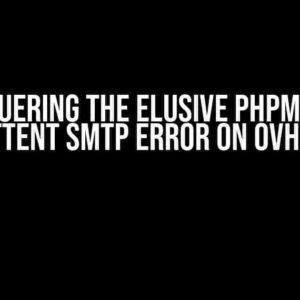Are you tired of dealing with licenses that can be easily bypassed by simply changing the computer clock? Do you want to create a foolproof license system that ensures your software is protected from unauthorized use? Look no further! In this article, we’ll show you how to create a C++ license that can’t be cheated by altering the computer clock.
Understanding the Problem
Before we dive into the solution, let’s understand why traditional license systems can be easily cheated. Most license systems rely on the computer clock to verify the license expiration date. However, this can be easily bypassed by simply changing the computer clock. This is where our solution comes in.
Using a Unique Identifier
The first step in creating a foolproof license system is to use a unique identifier that can’t be altered by the user. This can be achieved by using a combination of hardware and software-based identifiers.
One such identifier is the CPUID, which is a unique identifier assigned to each CPU. This can be accessed using the CPUID instruction in C++. Here’s an example code snippet:
#include <iostream>
#include <cstdint>
int main() {
uint32_t cpuId;
asm volatile ("cpuid" : "=a" (cpuId) : "a" (0) : "%ebx", "%ecx", "%edx");
std::cout << "CPUID: " << cpuId << std::endl;
return 0;
}
This code snippet uses the CPUID instruction to retrieve the CPUID and print it to the console.
Using a Cryptographic Hash Function
Once we have a unique identifier, we need to use a cryptographic hash function to generate a license key. A cryptographic hash function takes an input string and generates a fixed-size string that can’t be reversed.
In this example, we’ll use the SHA-256 hash function, which is a widely used and secure hash function.
#include <iostream>
#include <string>
#include <sstream>
#include <openssl/sha.h>
int main() {
std::string input = "CPUID:" + std::to_string(cpuId);
unsigned char hash[SHA256_DIGEST_LENGTH];
SHA256_CTX sha256;
SHA256_Init(&sha256);
SHA256_Update(&sha256, input.c_str(), input.size());
SHA256_Final(hash, &sha256);
std::string licenseKey;
for (int i = 0; i < SHA256_DIGEST_LENGTH; i++) {
std::ostringstream oss;
oss << std::hex << std::setw(2) << std::setfill('0') << static_cast<int>(hash[i]);
licenseKey += oss.str();
}
std::cout << "License Key: " << licenseKey << std::endl;
return 0;
}
This code snippet uses the SHA-256 hash function to generate a license key based on the CPUID.
Implementing the License System
Now that we have a license key, we need to implement the license system. This involves storing the license key in a secure location and verifying it against the license key generated at runtime.
One way to store the license key is to use a digital certificate, which is a file that contains the license key and other metadata. The digital certificate can be generated using a tool like OpenSSL.
To verify the license key, we need to compare the stored license key with the license key generated at runtime. If the two keys match, the license is valid; otherwise, it’s invalid.
#include <iostream>
#include <fstream>
#include <string>
int main() {
std::string storedLicenseKey;
std::ifstream file("license.crt");
if (file.is_open()) {
std::getline(file, storedLicenseKey);
file.close();
} else {
std::cerr << "Error: Unable to open license file." << std::endl;
return 1;
}
std::string runtimeLicenseKey = generateLicenseKey(); // implement generateLicenseKey() function
if (storedLicenseKey == runtimeLicenseKey) {
std::cout << "License is valid." << std::endl;
} else {
std::cerr << "Error: License is invalid." << std::endl;
return 1;
}
return 0;
}
This code snippet reads the stored license key from a digital certificate and compares it with the license key generated at runtime.
Advantages and Limitations
The advantages of this license system are:
- Uncheatable: The license system can’t be cheated by altering the computer clock.
- Unique: The license key is unique to each machine and can’t be used on another machine.
- Secure: The license key is generated using a cryptographic hash function, which makes it secure.
The limitations of this license system are:
- Complexity: The license system requires a good understanding of cryptography and C++ programming.
- Cost: Generating digital certificates can be costly, especially for large-scale deployments.
- Compatibility: The license system may not be compatible with all operating systems and hardware configurations.
Conclusion
In conclusion, creating a C++ license that can’t be cheated by altering the computer clock requires a combination of unique identifiers, cryptographic hash functions, and digital certificates. By following the steps outlined in this article, you can create a foolproof license system that ensures your software is protected from unauthorized use.
Remember to always keep your license system up-to-date and secure, and to test it thoroughly before deploying it in a production environment.
| Keyword | Description |
|---|---|
| CPUID | A unique identifier assigned to each CPU. |
| SHA-256 | A cryptographic hash function used to generate a license key. |
| Digital Certificate | A file that contains the license key and other metadata. |
Note: This article is for educational purposes only and should not be used for illegal or unethical activities. Always ensure that your license system complies with local laws and regulations.
By following the instructions outlined in this article, you can create a C++ license that can’t be cheated by altering the computer clock. Remember to always keep your license system up-to-date and secure, and to test it thoroughly before deploying it in a production environment.
Frequently Asked Question
Get the inside scoop on C++ licenses that can’t be cheated by altering the computer clock!
What is the purpose of a C++ license that can’t be cheated by altering the computer clock?
The purpose of such a license is to prevent users from tampering with the system clock to bypass the license expiration date or trial period, ensuring that the software is used in compliance with its intended terms.
How does this type of license verify the system clock?
These licenses often use various methods to verify the system clock, such as: synchronous online checks with a remote server, utilization of secure timing APIs, or implementation of algorithms that detect clock tampering attempts.
What are the benefits of using a C++ license that can’t be cheated by altering the computer clock?
The benefits include: protection of intellectual property, prevention of revenue loss due to license exploitation, and enhanced customer trust and satisfaction through fair and transparent software usage terms.
Are there any limitations or drawbacks to using such licenses?
Yes, some limitations may include: potential inconvenience to legitimate users who need to adjust their system clock for legitimate reasons, added complexity in license management, and potential compatibility issues with certain operating systems or hardware configurations.
Can I implement this type of license in my own C++ applications?
Yes, you can implement this type of license in your own C++ applications by utilizing available libraries, SDKs, or APIs that provide clock tamper-proofing functionality, or by developing your own custom solution tailored to your specific needs and requirements.

![C++ License that can’t be cheated by altering computer clock [duplicate] C++ License that can’t be cheated by altering computer clock [duplicate]](https://aktaion.hkhazo.biz.id/wp-content/uploads/sites/261/2024/07/c-license-that-cant-be-cheated-by-altering-computer-clock-duplicate-with-text.jpg)


